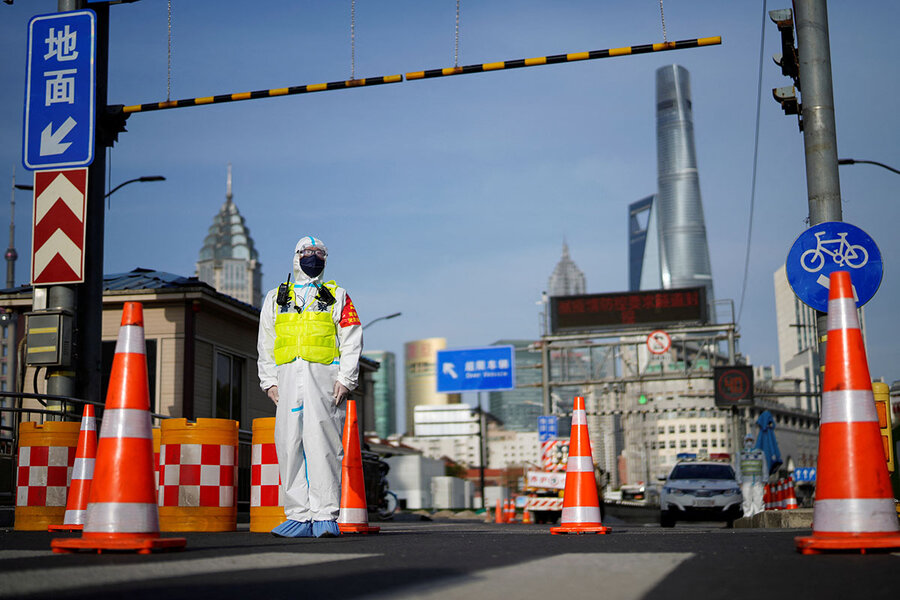‘Too high a price’: Why some residents oppose Shanghai lockdowns
Loading...
| Shanghai
Hunkered down in a high-rise apartment stocked with bags of rice and flour, Liu Zhen is resigned to the government-imposed lockdown – her first of the pandemic – even though she considers it overkill.
“Omicron has limited harm to our health,” says the retired schoolteacher, who’s using a pseudonym to protect her identity, as she braces herself for isolation in Shanghai’s Pudong District. “Our megacity should not come to a standstill!”
Why We Wrote This
To manage a growing coronavirus outbreak, Shanghai has swapped its more targeted COVID-19 strategy for a costly, citywide lockdown – China’s largest in years. Still, experts and residents wonder, is a more flexible approach possible?
Yet it has. Traffic was virtually absent from streets below Mrs. Liu’s home on Monday as the government began sealing off the metropolis of 25 million for mass testing. The drastic move – one Shanghai authorities had vowed to avoid – underscores the challenge China’s leaders face as they attempt to balance political, economic, and public health goals, all amid a historic surge in cases.
Experts say that even if authorities overcome the current wave, the ongoing lockdowns will ultimately prove too costly and isolating – and Shanghai and the rest of China must prepare to jettison the zero-COVID-19 policy in favor of a mitigation strategy.
Yanzhong Huang, director of the Center for Global Health Studies at Seton Hall University, agrees. “Public support for the zero-COVID strategy is in rapid decline, especially in large cities with more informed and open-minded populations,” he says.
Hunkered down in a Shanghai high-rise apartment stocked with bags of rice and flour, cooking oil, and vegetables, Liu Zhen is resigned to the government-imposed lockdown – her first of the pandemic – even though she considers it overkill.
“The lockdown isn’t necessary,” says the retired schoolteacher, who’s asked to use a pseudonym to protect her identity, as she braces herself for isolation in Shanghai’s Pudong District. “Omicron has limited harm to our health. Our megacity should not come to a standstill!”
Yet far below Mrs. Liu’s home, traffic is virtually absent from Shanghai streets. A few food delivery workers on motorcycles rush to fill an onslaught of takeout and grocery orders, as panic-buying has left some store shelves empty. Barricades block bridges and main roads. Schools have moved online, and many businesses are shuttered. Shanghai’s Disney Resort closed indefinitely this month.
Why We Wrote This
To manage a growing coronavirus outbreak, Shanghai has swapped its more targeted COVID-19 strategy for a costly, citywide lockdown – China’s largest in years. Still, experts and residents wonder, is a more flexible approach possible?
Mrs. Liu is one of more than 12 million people locked down in Shanghai on Monday as the government began sealing off the metropolis of 25 million for two phases of mass testing through April 5. The drastic move – one Shanghai authorities had vowed to avoid – underscores the challenge China’s leaders face as they attempt to balance political, economic, and public health goals, all amid a historic surge in cases.
“Facing the spread of such a highly transmissible variant, it’s almost impossible to adopt a targeted approach,” says Yanzhong Huang, director of the Center for Global Health Studies at Seton Hall University in New Jersey. “That encourages the use of more heavy-handed, extensive, and even excessive COVID control measures on a large scale – so that is the dilemma here.”
By global standards, the current outbreak in Shanghai and across mainland China is tiny, with about 35,000 confirmed symptomatic cases reported this month. But the numbers represent by far China’s biggest wave since the pandemic erupted in the city of Wuhan in late 2019. Until last month, total confirmed symptomatic cases were just over 109,000, so this recent wave accounts for about 25% of all COVID-19 cases ever confirmed in China. The nation recently reported its first COVID-19 fatalities in more than a year, after two people died in the northern province of Jilin.
The spike in cases marks a test for China’s strict zero-COVID-19 policy – and many residents’ patience – by thwarting authorities’ efforts to shift to more targeted pandemic control measures. Fast-spreading variants and thousands of asymptomatic cases, which China counts separately, led to the large-scale lockdown in Shanghai. Yet experts such as Dr. Huang say that even if the current wave is overcome, the ongoing lockdowns will ultimately prove too costly and isolating – and Shanghai and the rest of China must prepare to jettison the zero-COVID-19 policy in favor of a mitigation strategy.
“Public support for the zero-COVID strategy is in rapid decline, especially in large cities with more informed and open-minded populations,” says Dr. Huang, also a senior fellow for global health at the Council on Foreign Relations. Sporadic protests over the lockdowns have broken out in some Chinese cities, and grumbling about the zero-COVID-19 policy is widespread on social media.
In one typical comment Sunday, a netizen complained that in the third year of the epidemic, “there still aren’t norms that everyone can understand. Whenever there is an outbreak, I only see the simple and harsh blockade of the community, but not the delivery of people’s life necessities.”
Weighing the costs
Shanghai today epitomizes China’s dilemma as it seeks to balance the competing demands of public health and economic growth. At a top-level meeting on March 17, Chinese leader Xi Jinping called for minimizing the impact of epidemic controls on development, and as recently as Saturday, Shanghai authorities asserted that the city is too vital economically to close down entirely.
“If the world’s largest container port is suspended ... how many cargo ships will be stranded at sea?” asked Wu Fan, a member of Shanghai’s COVID Epidemic Prevention and Control Group, in an interview with the state-run People’s Daily. “We cannot afford it.”
Still, Dr. Wu, who is also deputy dean of Fudan University’s School of Medicine, acknowledged that Shanghai health officials were scrambling to contain the outbreak. She told People’s Daily that mass testing is like “mopping the floor with the faucet turned on.”
Meanwhile, the public is growing increasingly weary of COVID-19 restrictions. Locked down for the past two weeks in his neighborhood in Shanghai’s upscale Xuhui District, novel editor Gu Nan feels his life has come to a standstill.
“At home, my work productivity is not very high. My mind is wandering,” he says in a phone call, asking to withhold his real name so he can speak freely. “With everyone cooped up ... it’s easy to be in a bad mood or to feel down.”
Since March 13, Mr. Gu has undergone five mandatory COVID-19 tests. His neighborhood was initially sealed off for 48 hours, then for four more days, and now indefinitely. “We don’t know when this will be lifted,” he says. “We ask our neighborhood committee, and they aren’t clear about it either – everyone is awaiting notice.”
Testing ground
Until Monday’s two-phase, citywide lockdown, Shanghai had attempted to control the outbreak using a more targeted, grid approach aimed at early detection, with block-by-block testing, contact tracing, and sealing off hundreds of neighborhoods. Even that less draconian approach seemed overly risk averse to Mr. Gu.
“Maybe I have one or two cases in my community – but there are more than 1,000 people who have to stop everything. It is very unreasonable,” says Mr. Gu, who considers the virus as a mild illness for most people. “That’s too high a price.”
A less costly strategy, experts say, would be for China to prioritize the protection of older people and other at-risk groups while expanding hospital capacity to handle surges. Loosening the zero-COVID-19 policy would also require an education campaign to prevent panic after years in which government media has highlighted the pandemic’s dangers, and local officials have been fired for failing to prevent outbreaks, says Dr. Huang.
Many residents such as Mrs. Liu, the retired teacher, are now debating the value of the zero-COVID-19 restrictions. While viewing the lockdown as too harsh, she also worries that “if COVID is out of control, it will bring big problems. As citizens, we have no choice but just to ... cooperate with our government.”
Others such as Mr. Gu hope that Shanghai and China will move toward living with COVID-19, since there is no medical way to eradicate it.
“Everyone has the idea that we can coexist with the virus, because you have no way to control it or make the virus disappear completely,” says Mr. Gu.
As unannounced lockdowns swept the city last week, office worker Cui Le hurried home early, concerned she might be confined at her company. “They don’t tell you in advance about the lockdowns,” she says, withholding her real name to protect her identity. Since then, she’s been working from home, and her neighborhood remains open.
“In Shanghai, maybe this wave ... is an opportunity,” says Ms. Cui. “We can try and see whether we can relax a little. Shanghai can do it first and see if we can handle the result. Then we can slowly expand it.”










